This post contains affiliate links.

When analyzing the speed of their internet, most people do not even look at their modem. The truth is, your modem is one of the most important pieces of your internet connection. Without it, you wouldn’t be able to access the internet.
Ok, so a modem is required for an internet connection.
Will any modem fit the bill, or does your modem affect your internet speed?
Using the wrong modem can significantly affect the speed of an internet connection. If the modem is not rated to support the speed of the current internet plan, the internet speed of the network will be reduced to the maximum speed the modem can support.
In this post we’ll take a close look at modems and what you can do to make sure your modem is helping to optimize your internet connection.
What Is the Purpose of a Modem?
Modems act like translators for your devices. They take the signals that come to your house from the Internet Service Provider (ISP) and make them usable by your internet-connected devices. Without a modem, you wouldn’t be able to do anything with the internet connection coming from the ISP.
Why Do Modems Have to Translate Signals?
Depending upon the type of internet connection you have, you’ll have a different line coming to your house that connects you to the internet:
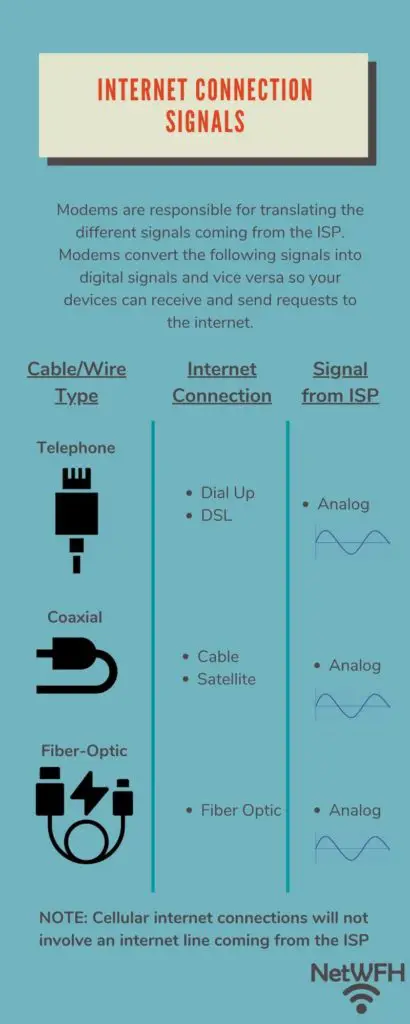
The different lines all provide your house or office with the same type of signal (analog), but your devices aren’t able to use the analog signal directly. That’s where the modem comes in.
As you may be familiar, computer devices communicate through a series of 1s and 0s, or binary code. Unfortunately, analog signals that are received by the ISP aren’t in this format.
It’s the modem’s job to take the analog signals received by the ISP (regardless of the internet connection type you have) and translate them into 1s and 0s for your devices.
What does this look like?
Essentially modems take this:

And make it look like this:

Why Don’t Computers Just Use Analog Signals?
This is a complex topic but I’ll provide a brief explanation.
Computer processors are made up of billions of transistors. Transistors can either be in an “on” state or an “off” state, much like a light switch. The position of these transistors indicates a specific value in binary code: 1 for an “on” state and 0 for an “off” state.
The 0 and 1 positions of all the transistors in a processor make up the binary code that computers use to execute.
Because transistors can only be “on” or “off”, computers struggle with analog signals. Analog signals are continuous signals with varying voltage. If you refer back to the previous diagram, you see that much of the time the voltage is something other than 0 or 1. Transistors would be confused by this because they wouldn’t know if they should be on (1) or off (0) when the voltage is between 1 and 0.
Modems smooth out the analog signal so the transistors know what position they should be in.
If you want to learn more about how computers use binary and digital signals to function, check out this article.
How Often Are Modems Making These Conversions?
Conversion of the analog signal from the ISP into a digital signal for your devices is done every time something is retrieved from the internet. To name a few examples, this occurs every time you:
- Land on a new web page
- Stream a TV show
- Open an email
Translation occurs in the opposite direction from digital to analog every time you send a request to the internet. This can be when you:
- Add an item to your shopping cart on Amazon
- Click “Send” on an email you wrote
- Click on a hyperlink on a website or in an email
As you can see, this translation is happening all the time when you’re using the internet.
When you consider that your modem is doing all of this work, you’ll realize how important its role is in your internet connection.
If your modem can’t keep up with all the translating it has to do, it’ll slow down your connection.
How Does My Modem Affect My Internet Speed?
Modems Can Limit Your Internet Speed
To help visualize how a modem can limit your internet speed, let’s take the example of a translator:

Let’s start with Karin the translator. She’s a very good translator that can translate 100 words/minute.
In this example, let’s say she’s given 500 words/minute to translate. Although she’s given 500 words/minute to translate, she’s only able to translate 100 of them.
In other words, she’s only capable of translating 100 words/minute no matter how many words are given to her each minute.
This is the same case with a modem:

If an ISP is providing speeds of 500 Mbps to the modem but the modem can only support 100 Mbps, only 100 Mpbs will be passed to your router. This means your internet speed will be capped at 100 Mbps.
A modem can’t provide internet speeds faster than what it’s rated for.
Modems Cannot Increase Your Internet Speed
If we go back to the translator example, what if Karin is only given 80 words per minute to translate?
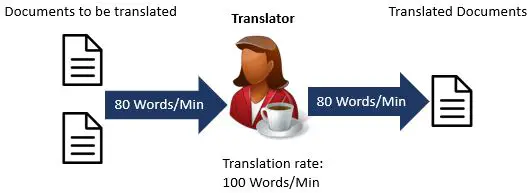
If she’s able to translate 100 words per minute but is only given 80 words per minute to translate, she’ll only translate 80 words per minute.
She can only translate the words at the rate that she gets them. She can’t translate more words per minute than she’s given.
Applying this to our modem example:

If your modem can support 100 Mbps but your ISP is only providing you with 80 Mbps, your maximum internet speed will be 80 Mbps.
A modem can’t increase the speed of your internet above what the ISP is providing.
What Does This Mean for My Modem?
The examples above illustrate the importance of a modem in your network.
If you’re not using the right modem for your network, it can limit the speed of your internet. On the other side of the coin, a modem can’t increase the speed of your internet.
At the very least, you should make sure your modem supports the data rate of your internet plan. Many people buy modems that support speeds faster than their current internet plan so they can upgrade their plan in the future without having to buy a new modem.
We’ll discuss that later.
What Does a Modem Look Like?
If you’re renting your router from your ISP, it’ll most likely have the modem built into it. This makes it difficult to identify what speed the modem is rated for. If you want to optimize the speed of your internet and the plan you are paying for, it is best practice to buy your own router and modem. This is a discussion that I will dive into in another article.
If you bought your own modem and router and they’re separate devices (which I recommend), your modem will look something like this:
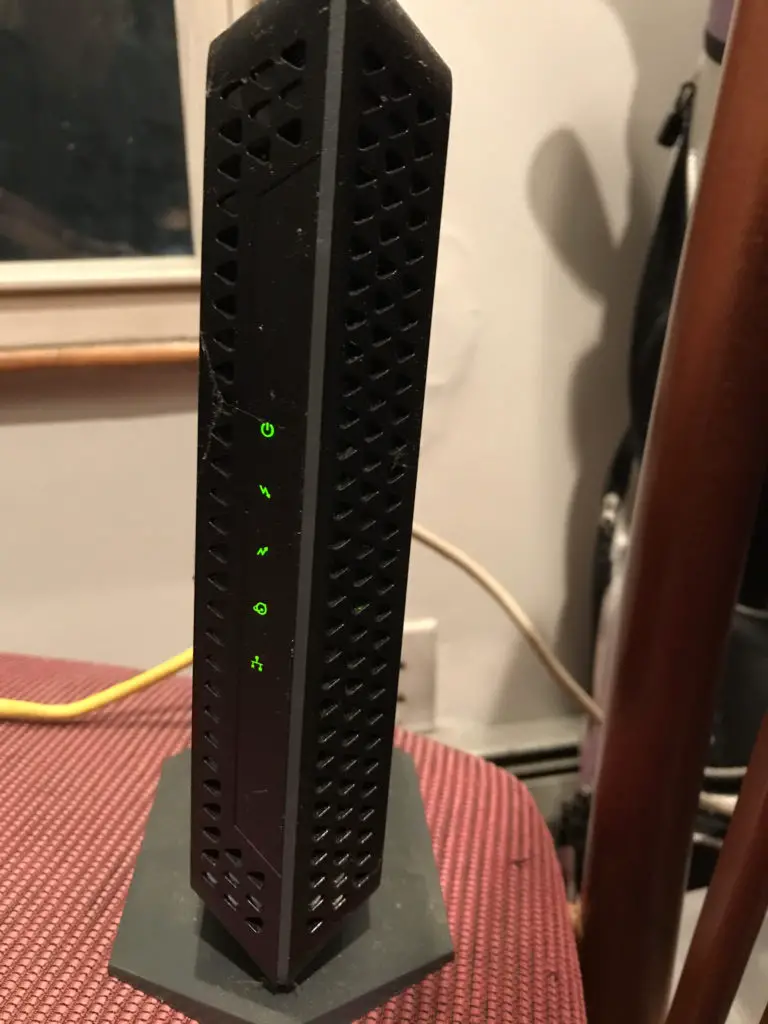
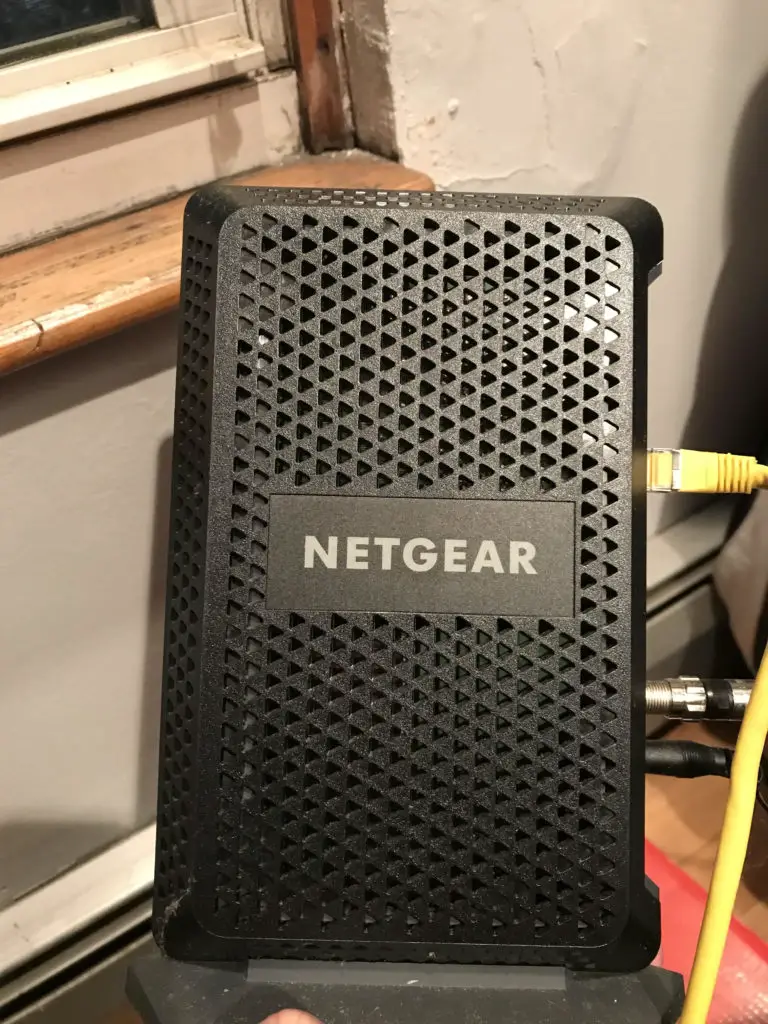
This is a Netgear CM600 modem for a cable internet connection.
You’ll find the following connections on the back of your modem:
- A power cord that connects to an outlet
- A cable that connects to your internet source (in this case a coaxial cable wall jack for my cable internet)
- An ethernet cable that connects to your router
It should look something like this:

Modems come in many shapes and sizes but for the most part they’ll have the same connections on the back.
Now that you’ve identified your modem, let’s make sure it supports the speed of your internet plan.
How Do I Know if I Have the Right Modem?
You’ll need to look up a few things to determine if your modem is a good fit for your internet plan. You’ll need to know the following:
- The data rate of your current internet plan
- The data rate that your modem supports
How Do I Check What Internet Plan I Have?
Your most recent internet bill will tell you what your maximum data rate from your ISP is.

The maximum data transfer rate I can expect from my current plan is 600 Mbps.
What Is My Modem Speed?
In looking at your modem, you won’t be able to determine what internet speed it supports. You’ll need to look up the make and model to see what the specifications are.
There will be a sticker on your modem that indicates its make and model. This sticker is on the bottom of the base of my modem:
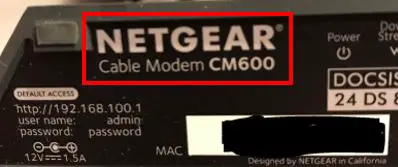
As you can see, I have a Netgear CM600 cable modem.
The next step for me is to Google the CM600 modem to determine its specs.
On the Netgear website it details the download speed that the CM600 is rated for:
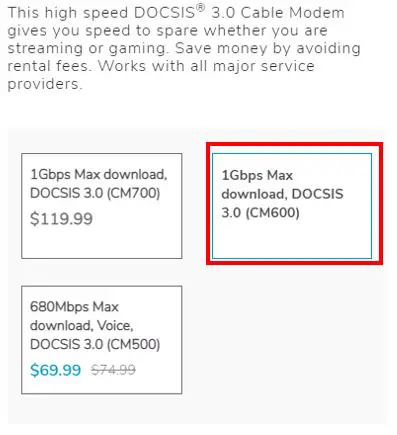
My modem is rated for 1 Gbps maximum download speed. I have a 600 Mbps internet plan with my ISP so I know my modem isn’t limiting my internet connection.
What Modem Should I Buy if I Have to Replace My Modem?
If your modem doesn’t support the speed of your current internet plan, it’s limiting your internet speed. You should buy a new modem.
What modem should you get?
To determine the right modem for you, you’ll need to take your current internet plan into account. You’ll also need to account for any upgrades that you may make to your plan.
Notes About Your Current Internet Speed
It’s important to note that you’ll rarely get the maximum data rate that the ISP advertises for your plan. Everyone in your area with the same internet provider is sharing the same wired connection back to the ISP. If there are many users connected to the internet at the same time, the maximum data rate will be lower than the maximum rate of your plan. This is normal and should be expected.
In my case, the internet plan I am signed up for has a maximum download speed of 600 Mbps, but I frequently see only 200 Mbps at a given time.
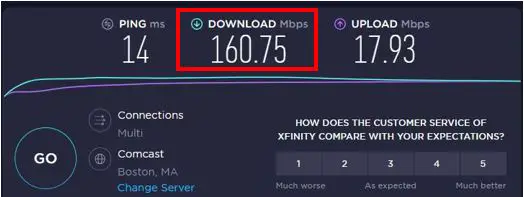
Even though you won’t be getting the maximum internet speed of your plan, it’s good practice to buy a modem that can (at least) support your maximum data rate.
If you buy a modem that supports speeds greater than your current plan, you’re “future proofing” your network. In other words, you won’t need to buy a new modem if you upgrade your plan in the future. This is good practice and I highly recommend doing this.
As stated previously, my internet plan is for 600 Mbps, but my modem supports download speeds up to 1 Gbps. If I upgrade my internet plan so that I’m getting 1 Gbps, I won’t have to upgrade my modem as well.
I feel comfortable that my modem will support my internet needs for the next few years, so it was worth the investment to spend a little extra to get a faster modem.
Standalone Modem vs. Router/Modem Combination
I would recommend buying a modem that is separate from your router.
This will allow you to buy a modem that is tailored to your specific internet plan.
You’ll also be able to upgrade your modem separately from your router if you need to. Router technology seems to be advancing faster than modem technology, so you don’t want to upgrade your modem each time your upgrade your router.
Depending upon your unique situation, there are some benefits offered by modem and router combination devices that should be considered as well.
It may be slightly more expensive to buy your modem separate from your router, but the flexibility it provides you is well worth it.
Make Sure Your Modem Supports Your ISP
When buying a modem you should also make sure it supports internet from your ISP.
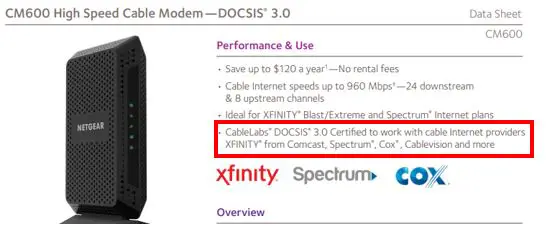
I have XFINITY Comcast internet, so when I bought my modem I had to make sure it supported XFINITY. Modems may also support different maximum speeds from different ISPs, so you’ll want to look into that as well.
For example, my Netgear CM600 supports speeds up to 960 Mbps for XFINITY Comcast, but only 400 Mbps for Spectrum internet. You need to be aware of this when making your decision.
Alternatively, most ISPs will have a list of modems that are compatible with their plans on their website. For example, XFINITY Comcast has a site where you can search to see if your modem is compatible with their internet.
If you buy a modem that’s not compatible with an ISP, it won’t work.
Modem Purchase Recommendations
Let’s bring this all together. Your modem does indeed affect your internet speed, so you need to make sure you make the right choice.
If you need a modem for your home network, you should consider:
- Buying your own modem as opposed to renting from the ISP
- Buying a standalone modem as opposed to buying a modem/router combination
- Ensuring your modem is compatible with the type of internet connection you have (e.g. a fiber-compatible modem for a fiber internet connection, a cable-compatible modem for a cable internet connection, etc.)
- Your current maximum internet speed
- Your current ISP and the modems that are compatible with your provider
- The amount of money you’re willing to spend on a modem (include savings due to “future proofing” in your calculations)
If you want recommendations on specific modem models and vendors, there are many articles online that have been written detailing your best options. I’ll give you a few ideas as well.
Good Value
As I mentioned previously, I really like my Netgear CM600 modem. It supports high speed internet (up to 400 Mbps), and it’s not as expensive as some of the other models.

I have had this modem for at least two years and I haven’t had any problems with it. If you only have a few people in your house and you don’t have any crazy internet needs, this modem will do just fine.
The Next Step Up
If you’re willing to spend a little more and you want to really future proof your home internet, the Netgear CM700 is a great choice.

The CM700 supports internet speeds up to 800 Mbps. Chances are, this modem can support your current internet needs no matter your home internet situation.
If you buy this modem, you can feel good about not having to replace it anytime soon.
Budget Friendly
For a budget-conscious option, you can’t go wrong with the Motorola Model MB7420.

It’s more affordable than the other two options I recommend, but will still provide enough firepower if you have basic internet needs.
This modem supports internet speeds up to 686 Mbps (even faster speeds than my CM600). This’ll be more than enough if you have multiple people in your household and a fast enough internet plan.
Wrap Up
I hope this guide helps you find the right modem for your internet needs. If you’d like to learn how your other home internet devices affect your internet speed, check out the following articles:
Does an Old Computer Affect Your Internet Speed?
Does a Router Affect Your WiFi Speed?
Can an Ethernet Cable Slow Your Internet Speed?
Is an Ethernet Cable Faster than WiFi?
Does Any Modem Work With Any Internet Provider?
Please contact me or comment below with any specific questions your might have about your modem.
Good luck and happy browsing!
